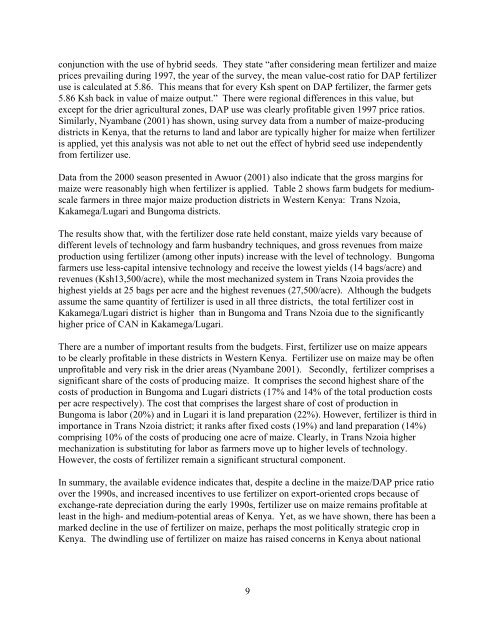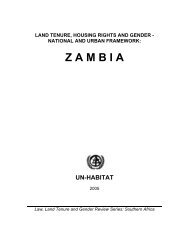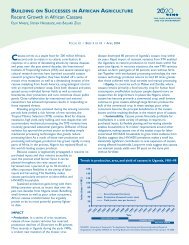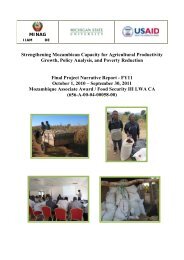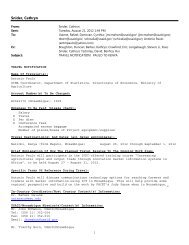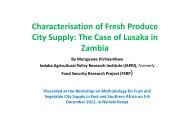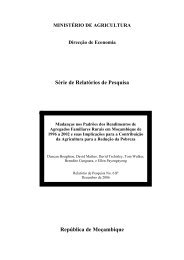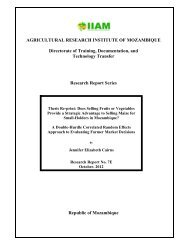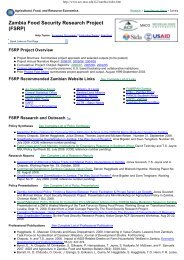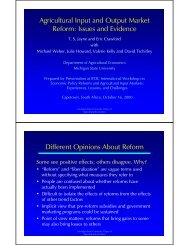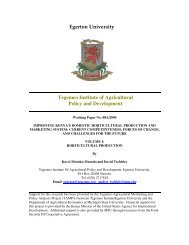Fertilizer Markets and Agricultural Production Incentives - Tegemeo ...
Fertilizer Markets and Agricultural Production Incentives - Tegemeo ...
Fertilizer Markets and Agricultural Production Incentives - Tegemeo ...
You also want an ePaper? Increase the reach of your titles
YUMPU automatically turns print PDFs into web optimized ePapers that Google loves.
conjunction with the use of hybrid seeds. They state “after considering mean fertilizer <strong>and</strong> maize<br />
prices prevailing during 1997, the year of the survey, the mean value-cost ratio for DAP fertilizer<br />
use is calculated at 5.86. This means that for every Ksh spent on DAP fertilizer, the farmer gets<br />
5.86 Ksh back in value of maize output.” There were regional differences in this value, but<br />
except for the drier agricultural zones, DAP use was clearly profitable given 1997 price ratios.<br />
Similarly, Nyambane (2001) has shown, using survey data from a number of maize-producing<br />
districts in Kenya, that the returns to l<strong>and</strong> <strong>and</strong> labor are typically higher for maize when fertilizer<br />
is applied, yet this analysis was not able to net out the effect of hybrid seed use independently<br />
from fertilizer use.<br />
Data from the 2000 season presented in Awuor (2001) also indicate that the gross margins for<br />
maize were reasonably high when fertilizer is applied. Table 2 shows farm budgets for mediumscale<br />
farmers in three major maize production districts in Western Kenya: Trans Nzoia,<br />
Kakamega/Lugari <strong>and</strong> Bungoma districts.<br />
The results show that, with the fertilizer dose rate held constant, maize yields vary because of<br />
different levels of technology <strong>and</strong> farm husb<strong>and</strong>ry techniques, <strong>and</strong> gross revenues from maize<br />
production using fertilizer (among other inputs) increase with the level of technology. Bungoma<br />
farmers use less-capital intensive technology <strong>and</strong> receive the lowest yields (14 bags/acre) <strong>and</strong><br />
revenues (Ksh13,500/acre), while the most mechanized system in Trans Nzoia provides the<br />
highest yields at 25 bags per acre <strong>and</strong> the highest revenues (27,500/acre). Although the budgets<br />
assume the same quantity of fertilizer is used in all three districts, the total fertilizer cost in<br />
Kakamega/Lugari district is higher than in Bungoma <strong>and</strong> Trans Nzoia due to the significantly<br />
higher price of CAN in Kakamega/Lugari.<br />
There are a number of important results from the budgets. First, fertilizer use on maize appears<br />
to be clearly profitable in these districts in Western Kenya. <strong>Fertilizer</strong> use on maize may be often<br />
unprofitable <strong>and</strong> very risk in the drier areas (Nyambane 2001). Secondly, fertilizer comprises a<br />
significant share of the costs of producing maize. It comprises the second highest share of the<br />
costs of production in Bungoma <strong>and</strong> Lugari districts (17% <strong>and</strong> 14% of the total production costs<br />
per acre respectively). The cost that comprises the largest share of cost of production in<br />
Bungoma is labor (20%) <strong>and</strong> in Lugari it is l<strong>and</strong> preparation (22%). However, fertilizer is third in<br />
importance in Trans Nzoia district; it ranks after fixed costs (19%) <strong>and</strong> l<strong>and</strong> preparation (14%)<br />
comprising 10% of the costs of producing one acre of maize. Clearly, in Trans Nzoia higher<br />
mechanization is substituting for labor as farmers move up to higher levels of technology.<br />
However, the costs of fertilizer remain a significant structural component.<br />
In summary, the available evidence indicates that, despite a decline in the maize/DAP price ratio<br />
over the 1990s, <strong>and</strong> increased incentives to use fertilizer on export-oriented crops because of<br />
exchange-rate depreciation during the early 1990s, fertilizer use on maize remains profitable at<br />
least in the high- <strong>and</strong> medium-potential areas of Kenya. Yet, as we have shown, there has been a<br />
marked decline in the use of fertilizer on maize, perhaps the most politically strategic crop in<br />
Kenya. The dwindling use of fertilizer on maize has raised concerns in Kenya about national<br />
9


